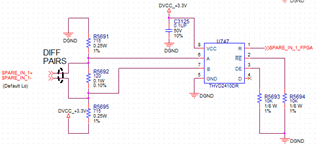Tool/software:
I intend to use the THVD2410 as a RS422 Receiver only. I have external termination resistors configured to have a default "Low" input. My external resistor configuration is 120 Ohms between Inputs A and B, 715 Ohm pull-down on Input A, and 715 Ohm pull-up on Input B. What effect will the internal Fail-safe circuitry have on my circuit? I'm expecting the Receiver Output to be "Low" for an Open-circuit bus condition and "High" for a short-circuit bus condition. The receiver will always be driven so the Idle bus condition is not an issue. Are my assumptions correct?
Thanks


